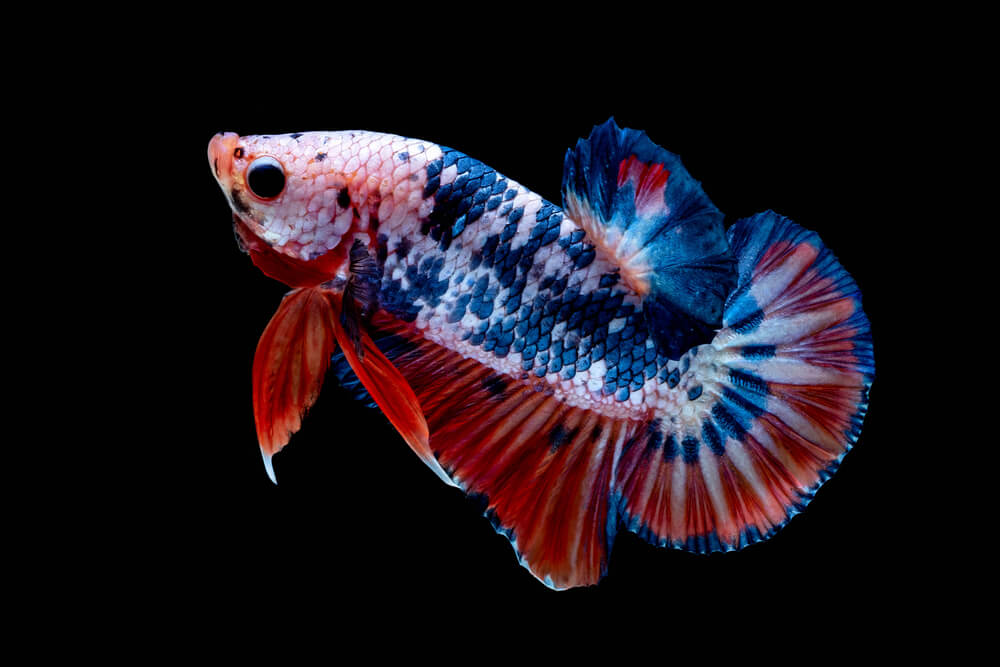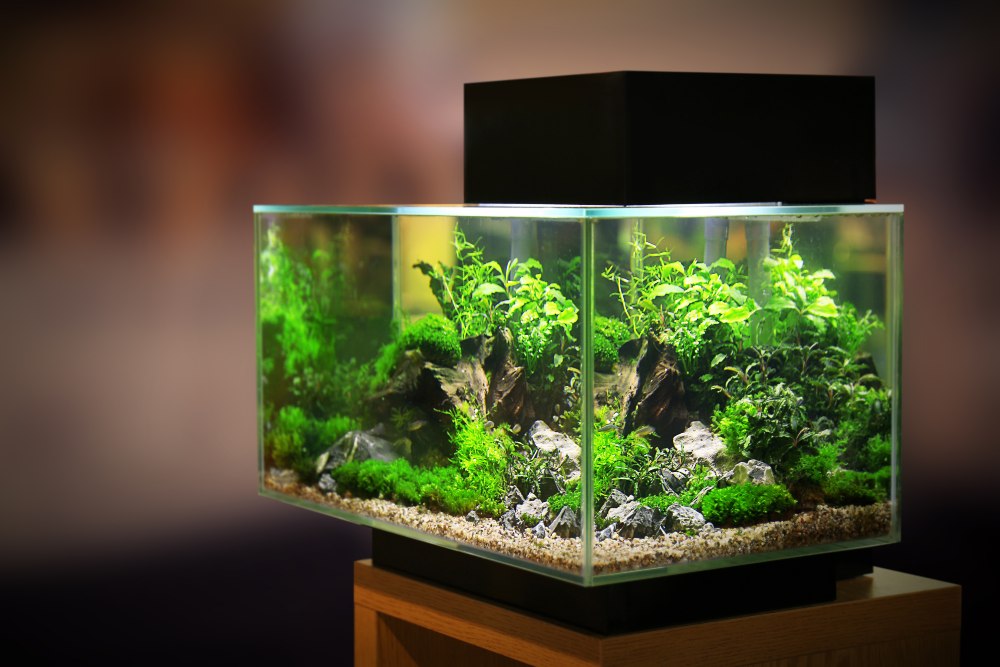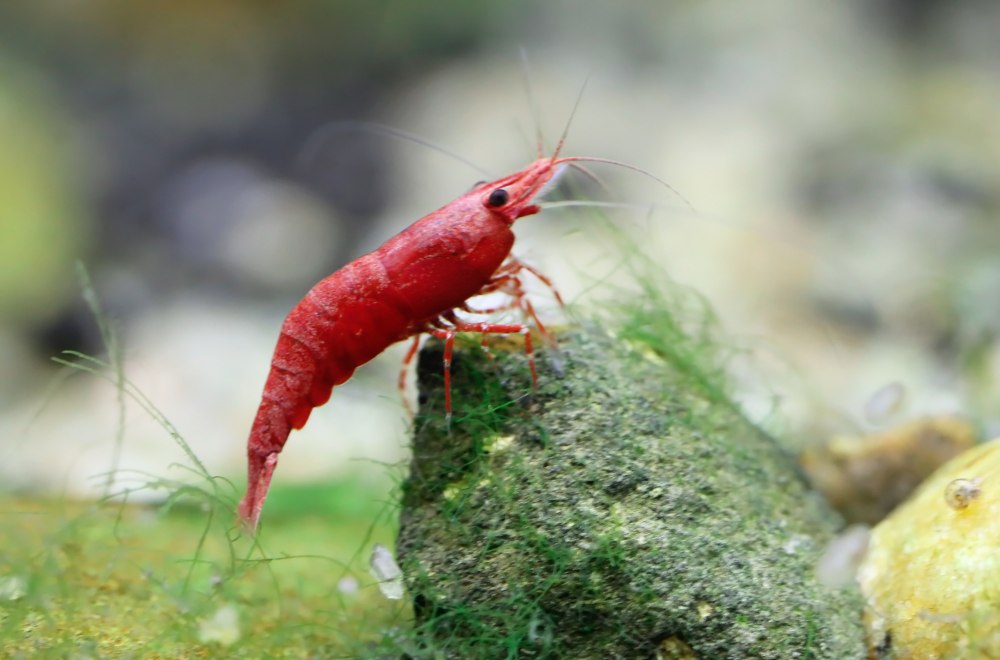There are many species of Siamese fighting fish—commonly known as betta fish—each one with unique tail and fin shapes and colors.
But one of the rarest types of betta fish is the stars and stripes betta fish. This spectacular fish is difficult to find due to limited breeding—it’s very unlikely you’ll find this vibrant fish in your local pet store (we’ll tell you where you can find this fish later on).
But what makes this betta fish unique? And why is it rarer than other types of betta fish? Let’s learn how this specific type of betta fish differs from the regular Siamese fighting fish you’re familiar with.
| Stars and stripes betta overview | |
| Appearance | Bright stripes all over the body |
| Length | Up to 2.5 inches |
| Temperament | Aggressive |
What is a stars and stripes betta?
A stars and stripes betta fish is a B. Splendens with a unique red, white, and blue, pattern on its body and fins that resemble stripes and stars.

However, regular betta fish can also develop stripes on their bodies over time. So does that make a regular betta fish the same as a stars and stripe betta fish? In this instance, no—stars and stripes betta fish have stripes on their bodies at all times, whereas a regular betta fish may develop stripes over time, mainly due to stress. The stripes of the stars and stripes betta are not from an illness or stress and are a natural pattern on their body.
In terms of size, a stars and stripes betta fish grow up to 2.5 inches, which is the same as other varieties of betta fish. Male bettas grow a bit bigger than females and male fish also have brighter bodies than females.
Temperament of the stars and stripes betta fish
Stars and stripes betta fish have the same feisty temperament as other types of betta fish. Due to their aggression, they have earned nicknames like the Siamese/Japanese fighting fish.
All Siamese fighting fish have a violent side and will fight to protect their territory when threatened. The fighting nature of betta fish is what caught the attention of people, and they used them for the pet trade. They are also extremely territorial and prefer to live alone.
Male stars and stripes bettas are more aggressive than female ones, so it’s never a good idea to keep multiple male betta fish in the same tank.
Tank requirements for a stars and stripes betta

Betta fish originally came from the coastal areas of Thailand. The natural home to these freshwater fish is rice paddies, slow-moving streams, and stagnant waters.
When designing a tank set-up, you must replicate the betta fish’s natural environment.
Stars and stripes betta fish are susceptible to their living conditions and won’t survive if not kept in a well-maintained tank. Here’s what you need to keep in mind to keep your stars and stripes betta fish healthy and happy.
Tank size
Although stars and stripes bettas don’t grow too big, they need huge tanks. If you thought you could keep it in a fishbowl or a vase, you’re hugely mistaken. Betta fish need room to swim and roam, and small vases, cups, and bowls, are inhumane.

A single stars and stripes betta fish needs a minimum five-gallon tank.
Star and stripes bettas, like all other betta fish, are very sensitive to water conditions and cleanliness, and you must keep your betta tank clean at all times.
Keep a good filter in the tank so that the water remains free from ammonia and other toxins. Again, the natural habitat of these fish does not have strong water currents; hence you should go for a mild water filter like a sponge filter.
If you have a filter, change 20% to 30% of the water weekly. If you don’t have a filter, you need to change 50% of the water weekly to ensure your tank is kept clean enough to keep your betta happy.
Water parameters
Stars and stripes bettas are used to living in warm tropical waters, so you have to provide them with similar water temperatures. Bettas can’t live in cold water, so it’s necessary you keep them in warmer waters only.
The ideal water temperature to keep the stars and stripes betta fish is 75 to 80 degrees Fahrenheit. Use a water heater inside the tank to maintain the water temperature—the temperature should be stable at all times, as frequent changes will stress out your betta fish.
Stars and stripes bettas can’t survive in acidic water. They prefer neutral waters, so make sure your tank’s pH remains between 6.8 and 7.5.
Tank decorations
Decorations not only make your tank look nicer, but they also make your betta fish happier. The original habitat of these freshwater fish is filled with vegetation, and it’s crucial to imitate the same in the tank, through decorations and plants. Additionally, betta fish need hiding places, and by adding lots of plants, you can ensure your betta has plenty of places to hide.
Use lots of live plants in the betta tank like Indian almond leaves, java ferns, java moss, and driftwood.
Make sure to keep some floating plants as well. Betta fish makes bubble nests, so floating plants are again another important addition to a betta fish tank.
Other tank decors include substrates like small pebbles, sand, and other such décor pieces. However, you must not keep any sharp objects as these can damage the star betta’s beautiful fins.
Diet
Stars and stripes bettas are carnivorous fish. Their natural diet includes a lot of protein-rich food like mosquito larvae, small insects, and fish. Most fish owners think that bettas will feed on aquarium plants, but that’s not true.
These fish can’t consume a plant-based diet, and if they do, they’ll fall sick. A healthy betta diet comprises good quality fish pellets, live food like bloodworms, brine shrimp, white worms, daphnia, and frozen or freeze-dried food.
Get betta food from trustable food suppliers to avoid any health risks. Again, always be careful about the quantity. Star bettas or any other betta fish need very small amounts of food.
Their ideal feeding time is just two minutes while keeping at least a 12-hour gap between meals. Basically, feed them twice a day. Bettas are eager eaters so clean any leftover food gathered at the tank bottom, otherwise, they’ll eat any food particles they can find in the tank, even if they have a full stomach. Overeating is extremely dangerous for the betta fish. It may lead to diseases like constipation, lethargy, bloating, and bulging eyes; if you see any such symptoms, don’t feed the fish for at least two days to let it recover.
Additionally, left over food will dirty your tank faster, disrupt the pH levels, and create an unsuitable living environment for your fish.
Tank mates for stars and stripes betta fish

Many people wonder if they can keep their stars and stripes betta fish in a community tank. We suggest you keep the stripes betta in a solitary tank. These tropical fish love having the entire tank to themselves since they are extremely territorial.
But if you want to house other species in the same tank, we would suggest you go for tank mates that don’t have the same aggressive nature as the betta. You can consider fish like neon tetras, small corydoras, and other aquatic animals like guppies, mystery snails, African dwarf frogs, and shrimps like Amano shrimp, cherry shrimp, and ghost shrimps.
These are mostly bottom dwellers, and betta fish spend most of their time at the water’s surface, so there will be fewer chances of fights. Just keep in mind that the minute the stars betta feels threatened, it will attack the other aquatic species.
Again, never keep two male betta fish together. The equally violent nature of both will make living in the same tank impossible. You can try housing male and female bettas together but keep a close eye on the fish. The male fish may get aggressive at any moment, hurting the female betta fish severely.
Stars and stripes betta appearance: natural or due to sickness?
The unique features and appearance of the stripes betta are uncommon, and people often wonder if it’s natural or if they’ve developed these stripes due to sickness.
Stripes in the betta fish body occur due to mutation, but stripes can indicate sickness, and if your stars and stripes betta suddenly develops more stripes than they normally have, they could be ill.
Stripes due to stress may develop due to inadequate water conditions. If the tank conditions or water quality is bad, it’ll stress out the betta fish, and stripes will start showing on its body.
Female betta fish develop stripes when they are ready to mate. The female betta signals the male betta through the stripes to show that they are ready to mate.
So how do you know whether the stripes are from stress or breeding?
You can easily determine which ones are stress stripes and which ones are breeding stripes by looking at the stripe pattern. Breeding stripes are vertical and stress stripes are horizontal.
With a stars and stripes betta fish, identifying stripes is a tad tricky because they already have stripes. We recommend taking photos of your stars and stripes betta fish so you can compare a photo of them in a healthy state to times when you think they may be developing more stripes. If your stars and stripes betta begins developing more stripes suddenly, it can be a sign of sickness, and you should seek help from a vet.
Where to find a stars and stripes betta fish
You can try looking in local pet stores for a stars and stripes betta fish, but chances are you won’t find one. The most reliable place to find a stars and stripes betta fish is through a betta breeder. Search for breeders in your area and ask if they have any available or know of other breeders who might.
Additionally, search through betta fish rescues to see if there are any stars and stripes in need of a loving home!
Conclusion
Stars and stripes bettas are a unique and rare betta breed. Like all types of betta fish in the Betta Splendens family, stars and stripes betta fish require a specific level of care.
If you own a stars and stripes betta fish, you’ll need to pay particular attention to their stripes and be aware if they start to develop more, which could indicate illness or stress.
Have you ever seen a stars and stripes betta fish? Drop a comment and let me know!

My daughter and her father went to the pet store to get a betta fish and they brought home a stars and stripe I am here reading about it and I am a intimidating very much he is beautiful it’s a meal
What a great find!
Atascocita tx had one and my daughter wanted it so we bought it. I have always had freshwater fish but never a betta fish.